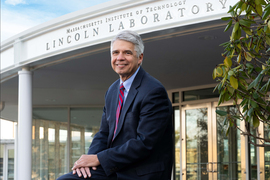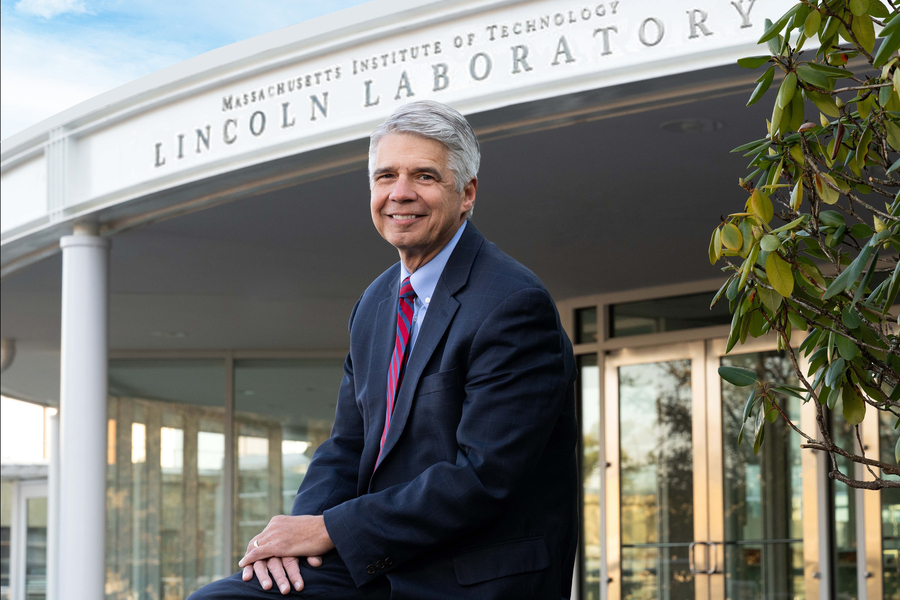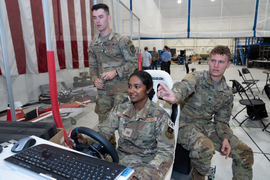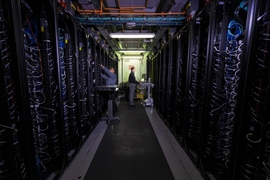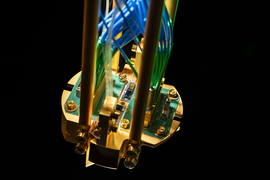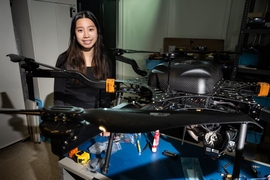Eric Evans will be stepping down as director of MIT Lincoln Laboratory on July 1, 2024, after 18 years leading a laboratory that has served the nation through its technology research and development since 1951.
Evans will transition into the role of fellow in the director’s office at Lincoln Laboratory. He will also hold an appointment on the MIT campus as a senior fellow in the Security Studies Program. He will support the ongoing growth of collaborative research and development between Lincoln Laboratory and the MIT campus, including in areas related to climate change as well as the exploration of advanced technology applications within the Security Studies Program.
The transition will mark the end of a successful tenure in which Evans led the laboratory to adapt and strengthen during a time of significant change for national security needs. He has also served as a key advisor on technology strategy to senior government leaders.
“It has been an honor and privilege to lead MIT Lincoln Laboratory,” Evans says. “I really appreciate what our laboratory community has done over many years to develop some of the nation’s most important and difficult technical advancements.”
Lincoln Laboratory is a federally funded research and development center that focuses on technology development, system prototyping, and capability transition to the government, commercial companies, and industry.
Under Evans’ leadership, the laboratory established new research and development mission areas in cybersecurity, homeland protection, and biotechnology, and started new programs in humanitarian assistance and disaster relief, climate change technology, quantum information science, and energy system resilience. Evans has also strengthened ties with the MIT research community, increased diversity and inclusion efforts, advanced STEM education initiatives, and developed new models for technology transfer to small and medium-size commercial companies.
Evans has also been a member and vice chair and is now chair of the Defense Science Board (DSB). The DSB investigates science and technology needs for the U.S. Department of Defense and strives to solve highly unstructured problems and develop new opportunities for the defense of the nation.
“During his two decades of service to Lincoln Laboratory, Eric’s leadership has proven what an ambitious R&D laboratory and a major institute can achieve together: transformative improvements to the systems that keep the world safe, and a lasting impact on the practice of innovation itself,” says Maria Zuber, MIT’s vice president for research. “Eric has been ahead of the curve in recognizing the global implications of emerging technology areas, and he’s been a trusted advisor on science and technology strategy. The culture of excellence, collaboration, and creativity that Eric has sustained at Lincoln Laboratory ensures its success well into the future. I’m thankful for his service and grateful that he will remain at MIT in his new roles.”
Zuber announced Evans’ decision in a letter to faculty and staff today. She will appoint a search committee to advise on the selection of the laboratory’s next director.
A career in service
Evans started at Lincoln Laboratory in 1988 as a technical staff member. After being named director of Lincoln Laboratory in 2006, he immediately began working with laboratory leaders and staff to develop new mission areas and programs based on national needs. He worked with many at the laboratory to establish a large homeland-protection mission area to create sensors and data integration systems to support the needs of the Department of Homeland Security. Under Evans’ leadership the laboratory developed new homeland air defense capabilities and chemical and biological sensor systems to defend against advanced threats.
Later, the laboratory established a cybersecurity mission area to address the dynamic threats posed by cyberattacks. Through many new programs, Lincoln Laboratory researchers developed technology to assist in the protection of defense and civilian cyber networks and to improve the cyber resilience of hardware and software for new computing systems.
The laboratory also started significant new work in biotechnology and human systems to develop advanced systems for monitoring health status and assisting in injury recovery for the Army and other sponsors. During the Covid-19 pandemic, Evans directed the laboratory to rapidly apply its biotechnology resources to the problems of medical resource allocation, health monitoring, automatic contact tracing, and virus dispersion analysis. Many of these technologies continue to be improved and transitioned to new applications.
Leveraging large defense investments for airborne ground mapping sensors and communication networks, the laboratory established new programs for humanitarian assistance and disaster relief, including rapid responses to the 2010 earthquake in Haiti, Hurricane Maria in Puerto Rico, and Hurricane Harvey in Houston, Texas.
Evans has also focused on expanding other programs to address civilian needs. For example, new aircraft collision-avoidance and weather avoidance technology developed with funding from the FAA has improved flight safety worldwide.
NASA-funded programs have also benefited from Lincoln Laboratory initiatives. A major milestone occurred in 2013 with the first two-way demonstration of wide-bandwidth laser communication between the moon and Earth. This innovation opened up new possibilities for NASA, which plans to use the technology to relay data across interplanetary distances.
“Eric is a gifted and impactful leader who has transferred advances in innovation and research beyond the borders of the lab, in service to the world,” says MIT Provost Cynthia Barnhart.
Stronger ties to MIT
Over the past 15 years, the number of Lincoln Laboratory research collaborations with MIT’s campus has increased by nearly a factor of four. The laboratory has expanded collaboration by providing funding for campus research, making many of its facilities available for campus researchers, supporting undergraduate and graduate teaching, and posing new research questions.
As a part of that collaboration, Lincoln Laboratory partnered with MIT’s School of Engineering in 2013 to establish the Beaver Works Center at MIT. The facility enables collaborative prototyping and technology development by MIT researchers and Lincoln Laboratory technical staff.
More recently, Lincoln Laboratory worked with the MIT Research Laboratory of Electronics to establish the Center for Quantum Engineering to develop new technologies for quantum computing, sensing, and communication. Lincoln Laboratory is also a contributor to the Department of the Air Force – MIT Artificial Intelligence Accelerator program.
A prominent example of research collaboration was the 2018 launch of the NASA Transiting Exoplanet Survey Satellite (TESS). Lincoln Laboratory worked closely with the MIT Kavli Institute for Astrophysics and Space Research to develop the highly sensitive cameras onboard TESS, which since its launch has discovered many new planets orbiting distant stars.
Striving for an inclusive culture and community service
Throughout his tenure, Evans has also taken steps to enhance the laboratory’s culture to be more inclusive and supportive, significantly increasing the percentage of women and people of color in technical and leadership roles. He established an Office of Diversity and Inclusion, appointed a chief diversity and inclusion officer, and strengthened the Human Resources Department to improve staff recruiting, development, and retention.
To support the national need for more diverse talent, Evans served for six years as the chair of the board for the National GEM Consortium, an organization that provides fellowships to underrepresented minorities pursuing graduate degrees in STEM fields. Through the efforts of many GEM volunteers and staff, the number of GEM fellowships increased significantly during Evans’ tenure leading the board. “I deeply appreciated being involved in this program supporting a critically important need,” Evans says. “The GEM mission is outstanding, and Lincoln Laboratory has very much benefited from their support and from the exceptional GEM Fellows we’ve hired.”
Evans has also strongly supported the creation of many programs to promote K-12 student interest in STEM fields. The laboratory’s STEM outreach programs have reached more than 100,000 students across the country, with nearly 8,000 students per year involved in programs that include building radars, designing small satellites, creating autonomous model cars, and developing new cryptography algorithms.
Positioned for future success
Moving forward, Evans has positioned Lincoln Laboratory to continue evolving its mission. The laboratory is currently pursuing research in emerging technology areas such as artificial intelligence, synthetic biology, and quantum systems and making major investments in new facilities and specialized laboratories.
As part of its facilities modernization, the laboratory recently broke ground for the construction of a large, $300M microelectronics laboratory to develop new technology for sensing and computing. A second $300 million Department of Defense investment is for an engineering prototyping facility that will begin construction in 2026. Several other new research and development facilities are planned through a long-term facilities modernization plan supported by the DoD. “These facilities investments will enable the laboratory to remain a strong center for developing revolutionary technology for decades to come,” Evans says.
After he steps down as director, Evans will continue to work with the defense community to support studies for current and future defense system and technology needs. He will also be developing and teaching courses related to technology for national security.
“MIT Lincoln Laboratory is a special place, and I have really enjoyed the experiences of leading and learning. I am most proud of the significant impact our creative leaders and staff have had on national security and society over many years,” Evans says.
